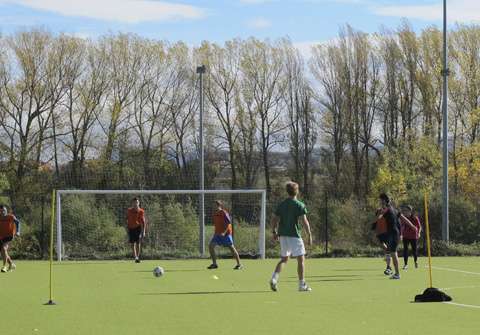Researchers at the UPV/EHU-University of the Basque Country have analysed the effect of different training exercises in football, known as small-sided games, on some physical and physiological variables of players aged 12 and 13 in order to find out which formats are most suited to their development. According to the study, some of these formats are not suitable for the youngest players.
PLOS ONE published the paper "Number of Players and Relative Pitch Area per Player: Comparing Their Influence on Heart Rate and Physical Demands in Under-12 and Under-13 Football Players." In this work, researchers at the UPV/EHU's Faculty of Education and Sports have analysed how football training exercises affect physical and physiological aspects in the under 12s (U12) and under 13s (U13).
This training method using so-called small-sided games (or long ones, depending on the number of players and dimensions) is very widespread in sports. Small-sided games or 'game-based training' are sports competitions or game-based training generally played by a smaller number of players and on smaller pitches (compared with 11-person football teams) in which all the internal logic components of the game are maintained in a way that is adaptable and motivating for the players. These activities are applied extensively in the sphere of football training and are fundamental in the programmes to develop young players.
This research combined a particular number of players per team (7, 9 or 11 players) who played on pitches with three different relative areas per player (100, 200 and 300 m2). In these situations, variables such as total distance covered, demands on the player, maximum speed, heart rate in various ranges of intensity, etc. were analysed; in other words, covering internal or physical variables as well as external or physical ones.
The results that emerged support the theory that a change in the format affects both categories of players in a similar way: "The greater the dimensions and the number of players per team, the greater the physical and physiological demands are, the latter being particularly high in the U13s with respect to the U12s," explained the researchers. So it seems that the U13s can develop their physical potential to a maximum.
Yet these demands, rated from the relative point of view, in other words, with respect to individual maximum speeds, show that the U12s endure a greater work load, bearing in mind that their maximum levels are lower with respect to the U13s. Nevertheless, it seems that in the U12 age group, it is not ideal to include large formats (>300 m2) or formats with many players per team (11).
The conclusions of the study could help trainers or people involved in this football training phase to plan progressive competition models in which the demands of the exercise are adapted to the physiological and physical development of the participants.
More information: Julen Castellano et al. Number of Players and Relative Pitch Area per Player: Comparing Their Influence on Heart Rate and Physical Demands in Under-12 and Under-13 Football Players, PLOS ONE (2016). DOI: 10.1371/journal.pone.0127505
Journal information: PLoS ONE
Provided by University of the Basque Country



















